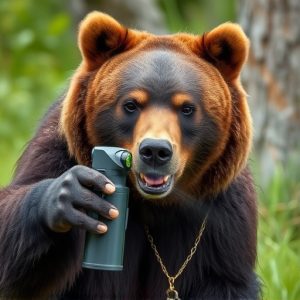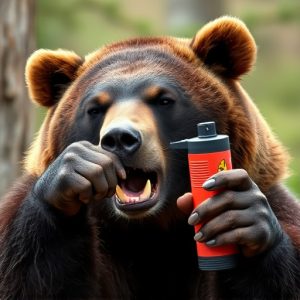Unraveling Bear Spray Range: Thirty Feet vs. Myth
Bear spray, a non-lethal defense against grizzlies, works best within 30 feet through its pepper for…….
Bear spray, a non-lethal defense against grizzlies, works best within 30 feet through its pepper formula, irritating the bear's senses and providing escape time. While commonly thought to have a 30-foot range, this is often overstated; bears can avoid or overcome sprays at greater distances, especially if agitated. Effective use requires understanding terrain, wind, and bear behavior, aiming low at the face for maximum impact. Proper storage and maintenance ensure its reliability in potential attacks, dispelling myths about grizzlies charging at every perceived threat.
Bear spray, a popular defense mechanism in bear country, is often touted as a reliable tool to deter aggressive grizzlies. But how accurate is its effective range? This article delves into the science behind bear spray, challenging the commonly accepted thirty-foot range claim. We explore the behavior of charging grizzly bears, debunk myths, and analyze factors influencing spray efficacy. Additionally, we provide safe usage and maintenance tips to ensure bear spray remains a reliable defense when encountering these majestic yet potent creatures in their natural habitat.
- Understanding Bear Spray: A Quick Overview
- The Reality of Bear Spray Range: Thirty Feet or More?
- Charging Grizzly Bears: Behavior and Myth Debunked
- Factors Affecting Bear Spray Efficacy
- Safe Usage and Maintenance Tips for Bear Spray
Understanding Bear Spray: A Quick Overview
Bear spray, also known as bear repellent, is a crucial tool for anyone venturing into bear country. Unlike what many believe, it’s not just about the spray itself but the understanding of its range and effectiveness. When compared to a charging grizzly bear, bear spray offers a non-lethal defense with a thirty-foot effective range. This means that if used correctly, individuals can create enough space to escape or turn the bear away without causing harm.
The key to bear spray’s success lies in its pepper-based formula, designed to irritate the bear’s eyes, nose, and respiratory system. When sprayed, it creates a protective barrier, allowing users valuable time to retreat or deter the bear. This simple yet powerful tool is a game-changer for outdoor enthusiasts, campers, and anyone living or visiting regions with high bear populations.
The Reality of Bear Spray Range: Thirty Feet or More?
The effectiveness of bear spray in deterring a charging grizzly bear has long been debated, with many relying on the commonly stated range of thirty feet (or ten meters). However, understanding the reality of this range is crucial when considering your safety in bear country. Studies have shown that the spray’s impact can vary greatly based on factors like wind, terrain, and the bear’s behavior—not just distance.
In optimal conditions, with no wind and a calm bear, thirty feet might offer some protection. However, bear spray vs. a charging grizzly is not always a straightforward comparison. In reality, bears can effectively avoid or overcome sprays at much greater distances, especially if they’re agitated or fleeing. Research indicates that while the initial spray may startle a bear, it’s the follow-up sprays that are more likely to stop an attack. Thus, proximity and multiple applications might be more critical than just reaching the stated range.
Charging Grizzly Bears: Behavior and Myth Debunked
Charging Grizzly Bears: Behavior and Myth Debunked
The perception of grizzly bears charging at humans is a common fear, often fueled by misinformation and dramatic media portrayals. However, understanding their behavior is crucial when considering bear spray as a defense mechanism. In reality, grizzlies typically avoid confrontation unless provoked or surprised. They are not inherently aggressive and will usually retreat if they sense danger. The myth of bears charging at every perceived threat can be misleading, especially when comparing it to the effective range of bear spray.
When faced with a potential threat, like someone using bear spray, grizzly bears have been observed displaying defensive behaviors but seldom charge directly. Their approach is often strategic and calculated, aiming to gain a better smell or view before deciding on a course of action. Bear spray, designed for such situations, can deter a bear from closing the thirty-foot effective range, providing crucial seconds to escape or reassess the encounter. Thus, understanding bear behavior and utilizing bear spray properly can significantly impact outcomes in potential encounters with these majestic animals.
Factors Affecting Bear Spray Efficacy
When considering the effectiveness of bear spray, several factors come into play, especially in comparisons like bear spray vs charging grizzly. The primary concern is always the distance at which it can be applied successfully. Typically, bear spray has a recommended effective range of thirty feet. However, this can vary based on several variables, including the quality and brand of the spray, weather conditions, and the specific behavior of the bear.
For instance, wind direction and speed can impact the spray’s reach and dispersion. A headwind might carry the spray away from the bear, while a tailwind could enhance its range. Additionally, factors like the age, size, and aggression level of the bear can also affect how it reacts to the spray. Younger or smaller bears might be deterred at a greater distance compared to larger, more charged adults. Understanding these dynamics is crucial for hikers and outdoor enthusiasts navigating areas known for bear activity.
Safe Usage and Maintenance Tips for Bear Spray
When using bear spray, it’s crucial to understand its effective range—thirty feet. This knowledge is vital for safe and effective deployment during encounters with charging grizzlies or other bears. Always remember to aim low, targeting the bear’s face and nose, as this area has a high concentration of olfactory receptors, which will maximize the impact of the spray.
For optimal performance, regular maintenance of your bear spray is essential. Keep it in its original container, out of direct sunlight and extreme temperatures. Periodically check the expiration date, as the effectiveness of the spray decreases over time. Ensure the safety seal remains intact until use. Before each trip into bear country, inspect the can for damage or leakage. Proper storage and handling will ensure that your bear spray is ready when you need it most, providing a reliable defense against potential bear attacks.
In examining the effectiveness of bear spray, particularly its range of thirty feet, it’s clear that understanding its limitations is crucial when navigating potential bear encounters. While bear spray can be a valuable tool in deterring charging grizzlies, it’s not a panacea. The reality of its range often falls short of the advertised thirty feet, especially in stressful situations. By recognizing the factors affecting its efficacy and following safe usage guidelines, individuals can make informed decisions when venturing into bear country. Knowing when and how to use bear spray versus dealing with charging grizzlies is key to ensuring safety in these wild encounters.


